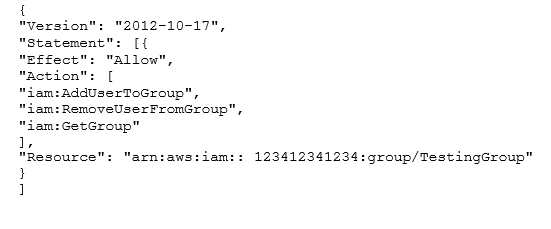What bandwidths do AWS Direct Connect currently support?
D
AWS Direct Connection currently supports 1Gbps and 10 Gbps.
Reference:
http://docs.aws.amazon.com/directconnect/latest/UserGuide/Welcome.html
The Principal element of an IAM policy refers to the specific entity that should be allowed or denied permission, whereas the translates to everyone except the specified entity.
A
The element NotPrincipal that is included within your IAM policy statements allows you to specify an exception to a list of principals to whom the access to a specific resource is either allowed or denied. Use the NotPrincipal element to specify an exception to a list of principals. For example, you can deny access to all principals except the one named in the NotPrincipal element.
Reference:
http://docs.aws.amazon.com/IAM/latest/UserGuide/reference_policies_elements.html#Principal
Doug has created a VPC with CIDR 10.201.0.0/16 in his AWS account. In this VPC he has created a public subnet with CIDR block 10.201.31.0/24.
While launching a new EC2 from the console, he is not able to assign the private IP address 10.201.31.6 to this instance.
Which is the most likely reason for this issue?
A
In Amazon VPC, you can assign any Private IP address to your instance as long as it is: Part of the associated subnet's IP address range
Not reserved by Amazon for IP networking purposes Not currently assigned to another interface
Reference:
http://aws.amazon.com/vpc/faqs/
A user is configuring MySQL RDS with PIOPS. What should be the minimum size of DB storage provided by the user?
D
If the user is trying to enable PIOPS with MySQL RDS, the minimum size of storage should be 100 GB.
Reference:
http://docs.aws.amazon.com/AmazonRDS/latest/UserGuide/USER_PIOPS.html
The Statement element, of an AWS IAM policy, contains an array of individual statements. Each individual statement is a(n) _________ block enclosed in braces
{ }.
C
The Statement element, of an IAM policy, contains an array of individual statements. Each individual statement is a JSON block enclosed in braces { }.
Reference:
http://docs.aws.amazon.com/IAM/latest/UserGuide/AccessPolicyLanguage_ElementDescriptions.html
If no explicit deny is found while applying IAM's Policy Evaluation Logic, the enforcement code looks for any ______ instructions that would apply to the request.
C
If an explicit deny is not found among the applicable policies for a specific request, IAM's Policy Evaluation Logic checks for any "allow" instructions to check if the request can be successfully completed.
Reference:
http://docs.aws.amazon.com/IAM/latest/UserGuide/AccessPolicyLanguage_EvaluationLogic.html
An organization is hosting a scalable web application using AWS. The organization has configured ELB and Auto Scaling to make the application scalable.
Which of the below mentioned statements is not required to be followed for ELB when the application is planning to host a web application on VPC?
A
Amazon Virtual Private Cloud (Amazon VPC) allows the user to define a virtual networking environment in a private, isolated section of the Amazon Web Services
(AWS) cloud. The user has complete control over the virtual networking environment. Within this virtual private cloud, the user can launch AWS resources, such as an ELB, and EC2 instances. There are two ELBs available with VPC: internet facing and internal (private) ELB. For the internet facing ELB it is required that the
ELB should be in a public subnet. After the user creates the public subnet, he should ensure to associate the route table of the public subnet with the internet gateway to enable the load balancer in the subnet to connect with the internet. The ELB and instances can be in a separate subnet. However, to allow communication between the instance and the ELB the user must configure the security group rules and network ACLs to allow traffic to be routed between the subnets in his VPC.
Reference:
http://docs.aws.amazon.com/ElasticLoadBalancing/latest/DeveloperGuide/CreateVPCForELB.html
An organization (account ID 123412341234) has configured the IAM policy to allow the user to modify his credentials.
What will the below mentioned statement allow the user to perform?
A
AWS Identity and Access Management is a web service which allows organizations to manage users and user permissions for various AWS services. If the organization (account ID 123412341234) wants their users to manage their subscription to the groups, they should create a relevant policy for that. The below mentioned policy allows the respective IAM user to update the membership of the group called MarketingGroup.
{
"Version": "2012-10-17",
"Statement": [{
"Effect": "Allow", "Action": [ "iam:AddUserToGroup",
"iam:RemoveUserFromGroup", "iam:GetGroup"
],
"Resource": "arn:aws:iam:: 123412341234:group/ TestingGroup " }]
Reference:
http://docs.aws.amazon.com/IAM/latest/UserGuide/Credentials-Permissions-examples.html#creds-policies-credentials
A user has configured EBS volume with PIOPS. The user is not experiencing the optimal throughput.
Which of the following could not be factor affecting I/O performance of that EBS volume?
B
If the user is not experiencing the expected IOPS or throughput that is provisioned, ensure that the EC2 bandwidth is not the limiting factor, the instance is EBS- optimized (or include 10 Gigabit network connectivity) and the instance type EBS dedicated bandwidth exceeds the IOPS more than he has provisioned.
Reference:
http://docs.aws.amazon.com/AWSEC2/latest/UserGuide/ebs-io-characteristics.html
How can multiple compute resources be used on the same pipeline in AWS Data Pipeline?
A
Multiple compute resources can be used on the same pipeline in AWS Data Pipeline by defining multiple cluster objects in your definition file and associating the cluster to use for each activity via its runs On field, which allows pipelines to combine AWS and on premise resources, or to use a mix of instance types for their activities.
Reference:
https://aws.amazon.com/datapipeline/faqs/